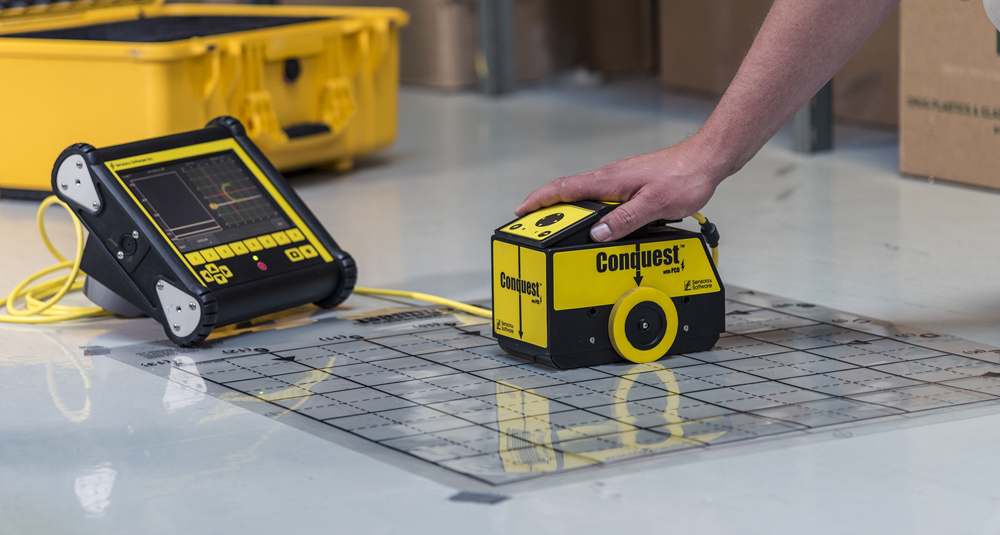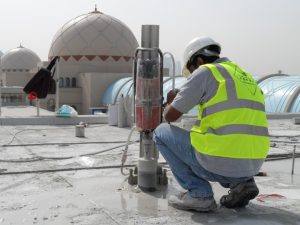Introduction to GPR Concrete Scanning
GPR concrete scanning is one of the most essential and advanced techniques used in modern construction projects to ensure safety, precision, and structural integrity. GPR concrete scanning provides a non-destructive and accurate way to locate hidden elements such as rebar, post-tension cables, electrical conduits, and voids inside concrete structures. By using GPR concrete scanning before any drilling, coring, or cutting work, construction teams can avoid costly damage and dangerous accidents. GPR concrete scanning ensures that every operation on site is performed safely and efficiently, without compromising the stability of the structure. In the UAE construction industry, GPR concrete scanning has become a mandatory step for maintaining high safety and engineering standards. Engineers, contractors, and project managers rely on GPR concrete scanning for reliable results that save both time and resources. Whether it’s a small renovation project or a large infrastructure development, GPR concrete scanning provides the accurate data needed to proceed with confidence and safety.
How GPR Concrete Scanning Works
GPR concrete scanning, also known as Ground Penetrating Radar scanning, works by sending electromagnetic waves into a concrete surface. These waves reflect back when they encounter materials of different densities such as metal, plastic, or air gaps. The reflected signals are then captured and processed to create a detailed image of the concrete’s internal composition. Using this technology, experts can locate and map objects embedded within walls, floors, or ceilings with exceptional precision. GPR concrete scanning is completely non-destructive, meaning it does not cause any harm to the structure being scanned. It is highly effective in detecting both metallic and non-metallic materials, making it a versatile solution for a variety of applications in construction, maintenance, and renovation projects. The speed and accuracy of GPR concrete scanning allow professionals to get immediate results on-site, ensuring work proceeds without unnecessary delays.
Benefits of Using Modern Equipment for GPR Concrete Scanning
1. Improved Accuracy and Clarity
Modern GPR concrete scanning equipment offers high-resolution imaging that helps detect even the smallest embedded objects. The advanced radar systems used today can differentiate between rebar, conduits, and voids, allowing for precise analysis and safe execution of construction activities.
2. Non-Destructive and Safe
GPR concrete scanning with modern equipment is completely safe for both workers and structures. It eliminates the need for invasive testing, ensuring that the concrete remains intact while delivering detailed information about its contents.
3. Real-Time Data and Results
With advanced technology, GPR concrete scanning provides immediate on-site results. This enables engineers and project managers to make quick, informed decisions without halting the workflow.
4. Cost and Time Efficiency
By preventing accidents and avoiding damage to hidden utilities, GPR concrete scanning reduces repair costs and minimizes downtime. Using modern equipment makes the process even faster and more efficient.
5. Versatility and Adaptability
Modern GPR concrete scanning systems can be used on a wide variety of surfaces—horizontal, vertical, or curved. This adaptability makes it suitable for complex projects like bridges, tunnels, airports, and skyscrapers.
Applications of GPR Concrete Scanning
GPR concrete scanning is used in a wide range of applications across the UAE. It plays a vital role in identifying reinforcement bars before drilling anchor holes, locating electrical or plumbing conduits during renovations, and detecting voids in concrete slabs before load-bearing assessments. For infrastructure projects such as bridges, highways, and tunnels, GPR concrete scanning ensures compliance with safety and engineering regulations. It is also used to verify concrete thickness, assess structural integrity, and perform quality control checks after construction. In commercial buildings, GPR concrete scanning prevents accidental strikes during installations, ensuring projects proceed smoothly and safely.
Why Choose Us for GPR Concrete Scanning Services
Highly Skilled Professionals
Our team of trained experts specializes in GPR concrete scanning using the most advanced equipment available. We bring years of industry experience to every project, ensuring accuracy and reliability.
Cutting-Edge Technology
We invest in the latest GPR scanning tools that provide clear, high-resolution imaging. This ensures every embedded object is detected before any drilling or cutting takes place.
Safety-Driven Approach
Safety is our top priority. Our GPR concrete scanning services are designed to eliminate risks associated with drilling into hidden cables or reinforcement, protecting both workers and structures.
Detailed Reporting
We deliver comprehensive reports that include subsurface visuals, object depth, and exact locations. These reports help engineers and contractors make confident, data-driven decisions.
UAE-Wide Service Coverage
We proudly serve all Emirates, including Dubai, Abu Dhabi, Sharjah, and Ras Al Khaimah. Our GPR concrete scanning services are available for projects of all sizes, from residential buildings to large infrastructure developments.
Importance of Safety and Precision in GPR Concrete Scanning
Safety and precision are the foundation of successful construction work. GPR concrete scanning ensures that drilling and cutting are performed only after all hidden elements have been accurately mapped. Striking post-tension cables or electrical conduits can lead to dangerous accidents, expensive repairs, and project delays. With GPR concrete scanning, such risks are virtually eliminated. The precision offered by modern equipment guarantees that each scan captures every detail within the concrete, allowing for well-planned, error-free operations. For UAE construction projects, where safety compliance is strictly enforced, GPR concrete scanning is not just a precaution—it is a necessity.
Frequently Asked Questions (FAQs)
1. What is GPR concrete scanning?
GPR concrete scanning is a non-destructive method that uses radar technology to detect and map embedded objects such as rebar, cables, and conduits within concrete structures.
2. Why should I use GPR concrete scanning before drilling or cutting?
GPR concrete scanning helps prevent damage to structural reinforcements and hidden utilities, reducing safety risks and avoiding costly repairs.
3. How accurate is GPR concrete scanning?
Modern GPR equipment provides highly accurate results, capable of identifying the exact location and depth of both metallic and non-metallic objects.
4. Is GPR concrete scanning safe for workers and buildings?
Yes, GPR concrete scanning is completely safe. It uses low-frequency radar waves that are harmless to humans and cause no structural damage.
5. How quickly can GPR concrete scanning be completed?
The process is fast and efficient. Depending on the size of the area, results are available immediately after scanning, allowing work to continue without interruption.
Conclusion
GPR concrete scanning with modern equipment is the safest and most precise method for examining what lies within concrete structures before drilling or cutting. It provides real-time, non-destructive results that protect both workers and structures. Our expert team uses state-of-the-art technology to ensure every project meets the highest standards of accuracy and safety. In the UAE’s fast-paced construction environment, GPR concrete scanning has become an essential step for maintaining quality and preventing costly errors. By choosing our professional GPR concrete scanning services, you ensure that every stage of your project is executed with confidence, precision, and care.





